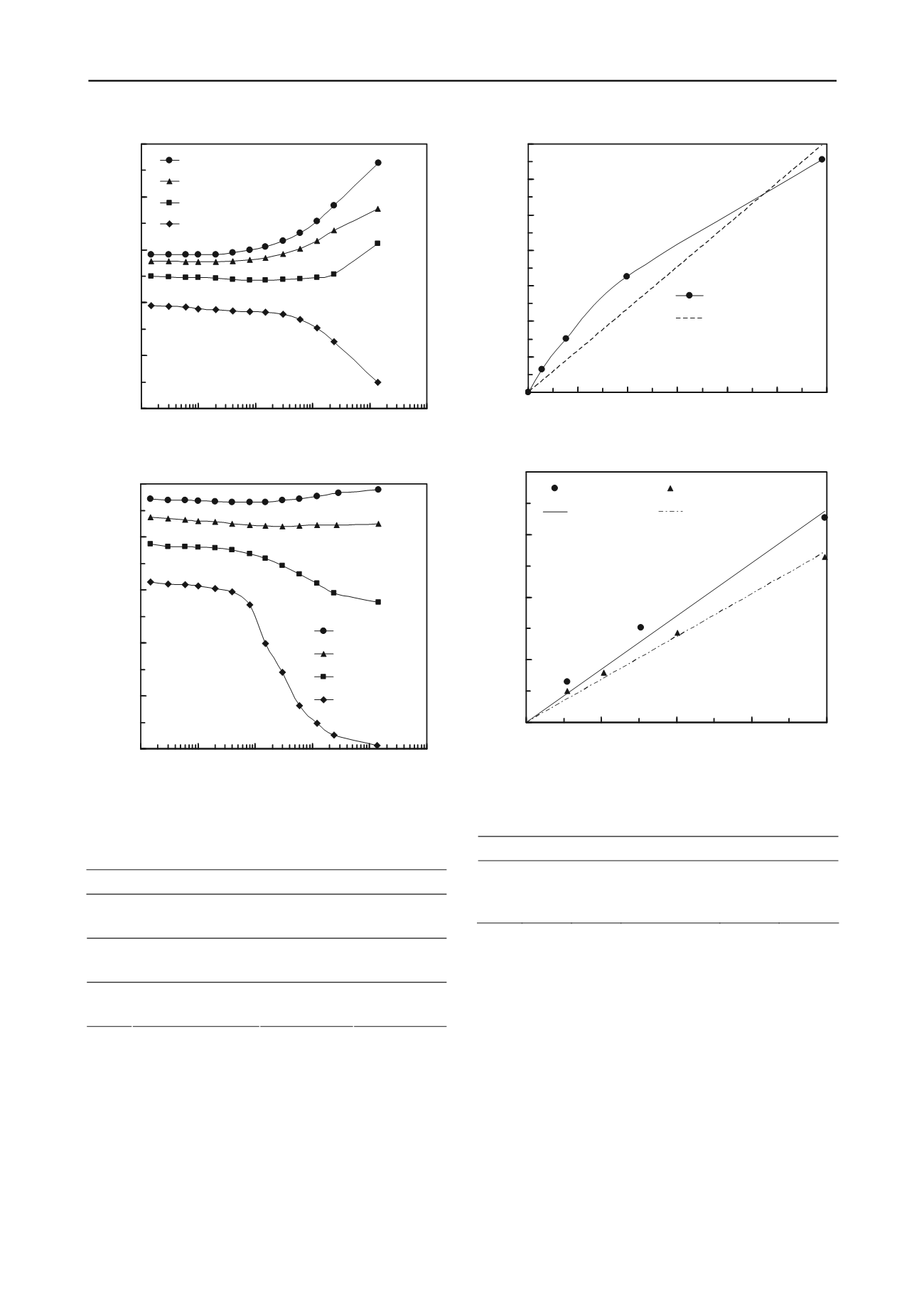
253
Technical Committee 101 - Session I /
Comité technique 101 - Session I
Proceedings of the 18
th
International Conference on Soil Mechanics and Geotechnical Engineering, Paris 2013
P2-S2
w = 25.8%
-0,8
-0,4
0,0
0,4
0,8
1,2
0,1
1
10 100 1000 10000
Time, t (min)
Specimen length change (mm)
a
σ'n=25 kPa
σ'n=75 kPa
σ'n=200 kPa
σ'n=600 kPa
(a)
.
.
.
.
.
.
P1-S2
w = 45.8%
0,0
0,2
0,4
0,6
0,8
1,0
0,1
1
10 100 1000 10000
Time, t (min)
Specimen length change (mm)
a
σ'n=25 kPa
σ'n=50 kPa
σ'n=100 kPa
σ'n=200 kPa
(b)
.
.
.
.
1
.
Figure 1. Typical results from the consolidation stage of ring shear tests.
Table 4. Soil behavior during the consolidation stage of ring shear tests.
Soil
Moisture content
w
(%)
Expansion
Compression
31.2
25, 75
a
250, 800
a
P1-S2
45.8
25, 50
100, 200
27.0
25, 75, 200
600
P2-S1
47.1
---------
25, 50, 100, 200
25.8
25, 75, 200
600
P2-S2
46.4
25
50, 100, 200
a
Values of effective normal stress
σ’
n
(kPa) used in the tests
clay fraction > 50% and a liquid limit between 60 and 220. The
fitting of the same experimental data with a linear failure
envelope is applied in Figure 2b, without considering the
measurement corresponding to the maximum effective normal
stress. As a result, a very high correlation coefficient, R
2
, is
obtained indicating that the failure envelopes of the soils with
optimum water contents can be considered as linear for
effective normal stresses up to 250 kPa. Typical residual failure
envelope obtained from specimens prepared with moisture
contents ranging from 46% to 47%, is also presented in Figure
2b. It can be stated with confidence that these failure envelopes
P2-S2, w = 25.8%
(a)
τ
r
= 0.1181σ'
n
R
2
= 0.9269
0
10
20
30
40
50
60
70
0 100 200 300 400 500 600
Effective normal stress, σ'
n
(kPa)
Residual shear stress, τ
r
(kPa)
Curved envelope
Linear envelope
P2-S2
(b)
τ
r
= 0.17σ'
n
R
2
= 0.9729
τ
r
= 0.137σ'
n
R
2
= 0.9884
0
10
20
30
40
0
50
100
150
200
Effective normal stress, σ'
n
(kPa)
Residual shear stress, τ
r
(kPa)
w = 25.8% w = 46.4%
Figure 2. Typical residual failure envelopes from ring shear testing.
Table 5. Values of residual friction angle
φ’
R
(degrees).
Soil
w
opt
w
opt
w= 46% – 47%
Difference (%)
P1-S2
7.3
a
8.8
b
8.8
17.0
c
0.0
d
P2-S1
8.4
a
9.1
b
8.7
7.7
c
4.4
d
P2-S2
6.7
a
9.6
b
7.8
30.2
c
18.8
d
a
For all values of effective normal stress used in the tests
b
For values of effective normal stress up to 250 kPa
c
Between the two angle values determined for w
opt
d
Between angles determined for w
opt
(σ’
n
≤ 250 kPa) and w= 46%-47%
are also linear because the resulting correlation coefficients
range from 0.98 to 0.99. Linear residual failure envelopes were
also obtained from ring shear tests conducted on Greek clayey
soils with effective normal stresses ranging from 50 to 400 kPa
(Kalteziotis 1993).
The values of the residual friction angle, φ’
R
, obtained in this
investigation, are summarized in Table 5. These values are
similar to those reported by other researchers (Bishop et al.
1971) and were determined after it was ascertained that the
values of residual cohesion, c’
R
, are negligible and can be set
equal to zero. If the curvature of the failure envelopes for
optimum water contents is not taken into consideration and all
experimental data are fitted with a linear failure envelope
(Figure 2a), the correlation coefficients are satisfactory (R
2
>
0.92) but the resulting φ’
R
values are even by 30% lower than


